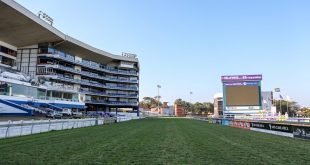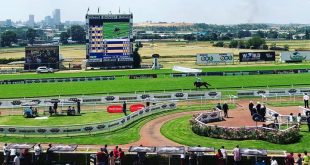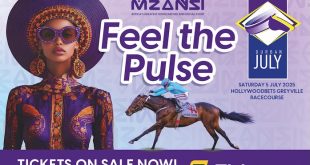David Thiselton
Recent Vodacom Durban Julys point to the advantage or disadvantage of the draw being related to the pace of the race and to the type of horse jumping from the draw concerned.
Another of the many keys factors in the race is the seemingly innocuous climb of about a metre in altitude from the 1600m to the 2000m mark, a hill which is not as well known as the four metre climb from the 700m mark to the straight, but which needs to be negotiated just as mindfully.
Luck in running also plays a big role and so does weight.
Jockeyship, particularly tactical nous, is important too.
Momentum into the straight is another key factor.
Statistician Jay August must once again be thanked for providing the statistics which allowed the sectional timing facts to be presented for the purposes of this article.
In the 2016 July draws 18 and 17 were the exacta positions and this year those two numbers finished third and first respectively.
In 2016 the pace was slow enough in the initial stages (74.08 seconds for the first 1200m) for The Conglomerate to ease his way into a handy position from draw 18 without expending too much energy under master tactician Piere Strydom. The luck factor in The Conglomerate’s case was that, having found a position one out and one back by the Drill Hall, the horse in front of him, It’s My Turn, opted to stay one wide without cover rather than move into the lead. The Conglomerate thus had perfect cover throughout. Furthermore, at the 1000m mark pacemaker Dynamic quickened the pace which meant The Conglomerate’s inherited stamina capacity was going to be maximised. Marinaresco, a hold up horse with a devastating turn of foot, had meanwhile been dropped out to the back from draw 17 and he would also have been grateful for the step up in pace. On the other hand the favourite Bela- Bela from a “good” draw of three was trapped on the rail and appeared to over race a touch during the moderately paced opening 1200m. She was able to stride out after Dynamic stepped it up, but the pace slowed again coming up the final hill which affected her momentum. Meanwhile, both The Conglomerate and Marinaresco, near the front and back respectively, had space on their outside so were able to build their momentum coming off the false rail. The Conglomerate maintained a resolute finish and held on by a quarter of a length from a flying Marinaresco.
Piere Strydom had also ridden the winner from draw 18 in 2012 on Pomodoro. On that occasion the initial pace had appeared to be quick and Strydom’s expertise is shown in that he was handy early but did not chase his mount from out wide in that 400m uphill section on the back straight. As luck would have it he failed to find cover so a lot of credit has to be given to Pomodoro. who was handy without cover virtually throughout and yet won in a fair time of 133.19 seconds.
In 2017 Marinaresco was drawn eight and was dropped out once again by Bernard Fayd’Herbe and yet won carrying topweight of 60kg as opposed to the 55,5kg he had carried as a three-year-old. The sectional times tell it all. The first 1200m was run in 73,13 seconds compared to 74.08 the previous year. They went 109.03 seconds through 1800m compared to 110.69 in 2016, 120 seconds through 2000m compared to 122,10 and the race time was 132.51 seconds compared to 133,50. Marinaresco’s strong finish was thus maximised and coming from near last he got up by a neck from Al Sahem. Early in the race the astute tactics of a couple of low drawn horses had effectively ended the chances of a number of widely drawn horses. In 2008 twice Vodacom Durban July-winning jockey Garth Puller, in an interview while walking the course, emphasised that when riding a low drawn horse who possessed stamina he would make an extra effort to keep the wider drawn horses out. The latter would then have to work up that 400m uphill section to get to the front and this would expose their stamina limitations. In the 2017 renewal. in line with this strategy, Callan Murray maintained a strong gallop up the back straight from draw two on The Conglomerate and S’manga Khumalo drove the SA Derby winner Al Sahem up the inside rail in behind him. The fancied It’s My Turn thus had to work hard to reach the front and his finishing position decreased from fourth the previous year to eighth. Interestingly the horse that came from draw 17 and worked hard to lead by the Drill Hall was Krambambuli, who had won the Western Cape Stayers over 2800m, and he managed to stay on for fourth.
In this year’s race the overall time of 132,4 seconds was the fourth fastest in the race’s 2200m history, but the sectional times were likely the fastest in history. Silvano’s Pride went through the 1200m mark in a blistering 69,36 seconds and after overtaking her Rainbow Bridge and Golden Ducat went through the 1800m in 107,46 seconds. Therefore, Belgarion, Do It Again and Got The Greenlight simply had to be dropped out to nullify their wide draws. The connections of Rainbow Bridge from a low draw had decided to go handy but they likely went too fast too soon and might also have chased too hard coming up the hill towards the straight. He was thus a sitting duck for the aforementioned strong-finishing trio. However, Rainbow Bridge’s performance compared to Do It Again was actually the same as it had been the previous year, so he ran a fine race all the same. The fancied Vardy was taken to the rail from a nine draw and his momentum going into the straight was not as good as the first three finishers who were able to get the slingshot affect off the false rail into the outside section of the straight. Weight was the factor which allowed Belgarion to beat Got The Greenlight and Do It Again.
The 2018 race was very slow throughout but the key was Anton Marcus managing to find cover on Do It Again in the back straight, despite jumping from draw 15. Luckily in mid race the horse in front of him, African Night Sky, kindly vacated his spot to go to the front, which brought Do It Again from the back half into the front half. The big horse had space on his outside so was able to build momentum into the straight and his speed did the rest.
The 2019 race was almost as slow but Do It Again once again had cover throughout from draw eight and was able to build up momentum into the straight thanks to an opportunistic move off the rail by Richard Fourie. Rainbow Bridge’s good draw of three was on that occasion advantageous as he found a perfect position in the vanguard for free. If the pace had been quicker it would have aided his cause so it was not surprising the same tactics were employed a year later with an expected quicker pace.







